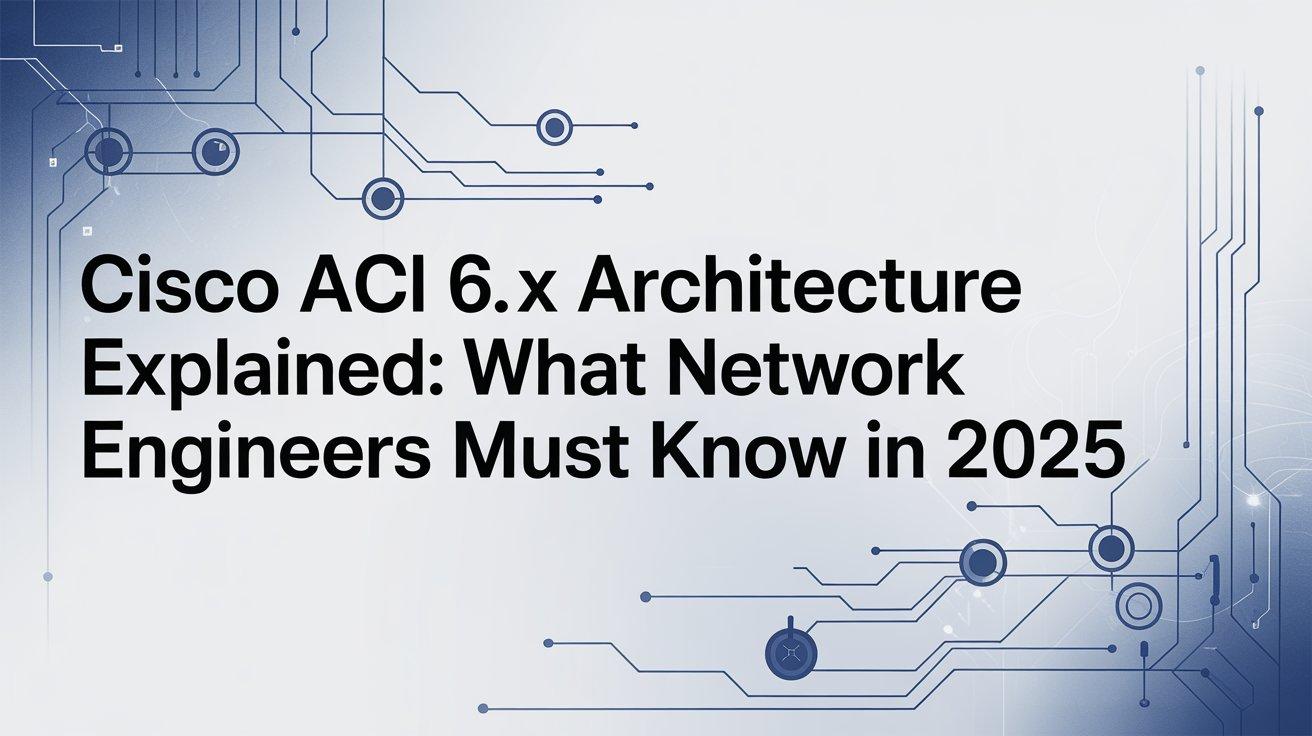Cisco ACI 6.x Architecture Explained: What Network Engineers Must Know in 2025

Introduction
Modern data centers are transforming rapidly, and network engineers need to understand how new technologies work behind the scenes. Many professionals exploring Cisco ACI Training often hear about ACI 6.x and wonder what makes it different from earlier versions. Cisco ACI (Application Centric Infrastructure) continues to evolve, and version 6.x brings new capabilities, stronger automation, and improved security—all essential for supporting modern applications and cloud environments.
This blog explains Cisco ACI 6.x architecture in simple terms, focusing on what engineers must know in 2025.
What Is Cisco ACI?
Cisco ACI is a software-defined networking (SDN) solution designed for data centers. Instead of configuring network devices one by one, ACI uses centralized policies to control switches, workloads, and applications. It creates a fabric that is easier to manage, scales better, and offers high performance.
At its core, Cisco ACI is built around three main parts:
-
APIC (Application Policy Infrastructure Controller)
-
Leaf switches
-
Spine switches
These components work together to form a reliable and programmable network fabric.
What’s New in ACI 6.x?
Cisco ACI 6.x introduces improvements that help organizations handle modern workloads, hybrid cloud, and automation needs. Some of the key enhancements include:
-
Updated APIC interface with clearer workflows
-
Improved automation and API capabilities
-
Better integration with cloud environments
-
Stronger visibility and monitoring tools
-
Simplified operations for large-scale fabrics
Engineers taking a Cisco ACI Course or working with enterprise data centers will
Understanding the Core Architecture of ACI 6.x
To understand how ACI 6.x works, let’s break down the main architectural elements in a simple way.
1. The APIC Controller Cluster
APIC is the “brain” of the entire ACI fabric. It stores policies, manages configurations, and communicates with all switches. ACI 6.x enhances APIC by providing:
-
A cleaner, more intuitive UI
-
Better performance for large deployments
-
Enhanced REST API and automation support
The APIC does not directly forward traffic. Instead, it tells the switches how to forward traffic using policies.
2. Leaf and Spine Architecture
ACI uses a fabric-based design made of leaf and spine switches:
-
Leaf switches connect to servers, firewalls, routers, and other edge devices.
-
Spine switches connect only to leaf switches, never to endpoints.
This design ensures predictable performance and simplifies scaling. If you add more devices or expand the fabric, the architecture continues to work smoothly.
ACI 6.x optimizes traffic flow across the leaf–spine layers and improves fabric resiliency.
3. Endpoint Groups (EPGs)
EPGs are a core concept in ACI. Instead of assigning VLANs or ACLs device by device, ACI groups endpoints based on policies.
For example, all web servers can belong to one EPG, and all database servers can be in another.
ACI 6.x allows even more flexible grouping and improved policy control, making it easier to secure applications.
4. Contracts and Policies
In ACI, communication between EPGs is controlled by contracts. A contract defines what type of traffic is allowed—for example, HTTP or SQL.
ACI 6.x enhances contract handling by improving:
-
Application visibility
-
Security policy checks
-
Logging and monitoring
This helps engineers understand how traffic flows across the data center.
5. Enhanced Automation and API Support
Automation is becoming a must-have in modern networks. ACI 6.x expands automation support with:
-
Better API documentation
-
Stronger integration with tools like Ansible, Terraform, and Python
-
Streamlined configuration templates
This helps engineers deploy faster and reduce manual errors.
6. Improved Visibility and Insights
ACI 6.x provides deeper visibility into:
-
Traffic patterns
-
Application health
-
Network performance
-
Security posture
These insights help teams troubleshoot issues faster and maintain a more stable network.
Why ACI 6.x Matters in 2025
The shift toward hybrid cloud, microservices, and containerized applications requires a flexible and intelligent network. Cisco ACI 6.x supports modern workloads by offering better policy control, enhanced automation, and scalability. Network engineers who understand these features will be better prepared for future data center challenges.
Conclusion
As data centers become more dynamic, understanding Cisco ACI 6.x architecture is essential for engineers working with large-scale or modern application environments. The improvements in automation, policy control, visibility, and scalability make ACI 6.x an important upgrade for organizations moving toward flexible and cloud-ready networks. For professionals looking to grow in this field, exploring Cisco ACI Training Online or preparing for Cisco ACI Certification can help build the skills needed to manage these advanced infrastructures confidently.
- AI
- Vitamins
- Health
- Admin/office jobs
- News
- Art
- Causes
- Crafts
- Dance
- Drinks
- Film
- Fitness
- Food
- Oyunlar
- Gardening
- Health
- Home
- Literature
- Music
- Networking
- Other
- Party
- Religion
- Shopping
- Sports
- Theater
- Wellness


